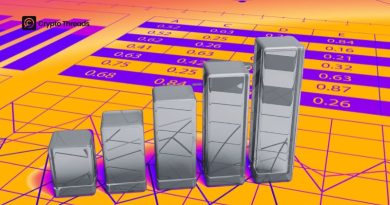How to Get Crypto Data: Your Essential Guide for Analysis
Introduction
The crypto market is incredibly volatile and moves with lightning speed. You can’t simply pick a random ticker, buy it, and expect the asset will automatically make you a huge amount of money; that’s essentially gambling. To navigate this dynamic landscape and make more sensible decisions, we need reliable data. This data forms the bedrock of sound analysis, allowing us to move beyond assumptions circulating on social networks and instead rely on evidence. Only when we see effects backed by data can we gain confidence and reason to make our moves in the crypto market.
In this article, I will guide you through the most common types of data, where to find them, and the methods for accessing them, covering sources that offer everything from simple CSV files for basic analysis in Google Sheets or Excel to those requiring more technical approaches like APIs and programming.
Why Data is Crucial for Crypto Analysis
Why should we even care so deeply about data in the world of cryptocurrency? Simply put, data is the foundation upon which all meaningful analysis is built. The crypto market is notoriously prone to misinformation and speculation. One moment, you’ll hear predictions of massive gains for a specific coin; the next, warnings of an imminent market collapse. To separate yourself from this noise, you must conduct your own analysis. Relying on others’ pronouncements without verification leaves you vulnerable and without a clear path for improvement. When you conduct your own analysis using data, you take responsibility for your findings. If your analysis is flawed, you learn directly from the outcome, allowing you to refine your methods. Without data, analysis is indeed just speculation, based on gut feelings, rumors, or biased opinions rather than verifiable facts.
Understanding the Different Types of Crypto Data
You might wonder, just how many different types of crypto data are available? The crypto ecosystem generates a surprising variety of data points, each useful for different analytical approaches. Here are the primary categories you’ll encounter:
Market Data
For many types of analysis, particularly technical analysis and basic market overview, you’ll likely work with price and volume data (Market Data) most frequently. Market data is incredibly versatile; you can use it for backtesting trading strategies, performing statistical analysis like regression, and generating charts and indicators. There are abundant resources available showing you how to work with this data.
Some specific data you may see in Market Data type:
– Historical Prices (OHLCV – Open, High, Low, Close, Volume)
– Real-time Prices
– Market Capitalization
– Trading Volume (24h, total)
– Order Book Data
– Funding Rates (for derivatives)
Blockchain Data (On-Chain Data):
On-chain data is a newer, powerful category unique to blockchain technology. Due to the inherent transparency of most public blockchains, you can see what every participant is doing (or at least, what their wallet addresses are doing). This opens up fascinating opportunities to track transaction volumes, monitor “whale” activity (large holders), or analyze the flow of tokens within a network.
Some data type you could get are:
– Number of Transactions
– Active Addresses
– Transaction Fees
– Block Information (size, time)
– Staking/Mining Data
– Token Flows (especially for specific tokens)
Social & Sentiment Data:
Social and sentiment data, while potentially insightful, can be very noisy. The crypto space on social media is highly active but also full of hype and low-quality information, requiring significant data cleaning and sophisticated tools to extract meaningful sentiment like:
– Social Media Mentions (e.g., Twitter, Reddit)
– News Article Sentiment
– Forum Activity
Fundamental/Project Data:
Finally, fundamental analysis involves diving deep into the specifics of a project – its whitepaper, tokenomics (how the token is designed and distributed), the team behind it, and the problem the protocol aims to solve. While some of this data (like supply) is available via APIs, much requires manual research and reading.
– Tokenomics (supply, distribution)
– Project Team & Roadmap
– Whitepaper Information (often not easily automated)
Where to Find Crypto Data: Key Sources
With diverse data types comes a variety of sources. Fortunately, there are many resources available, ranging from free options perfect for getting started to more comprehensive paid services. Here are some of the main places people turn to for crypto data:
- Cryptocurrency Exchanges:
– Primary source for market data (historical and real-time for pairs traded on that exchange).
– Examples: Binance, Coinbase, Kraken, etc.
– Often the most granular market data source. - Crypto Data Aggregators:
– Compile data from multiple exchanges and sources.
– Provide a broader market view.
– Examples: CoinMarketCap, CoinGecko, CryptoCompare, Nomics.
– User-friendly websites, often offer free APIs. - Blockchain Explorers:
– Direct access to on-chain data for specific blockchains.
– Examples: Etherscan (Ethereum), Blockchain.com (Bitcoin), BscScan (Binance Smart Chain).
– Offer web interfaces and often APIs for programmatic access. - Specialized Data Providers:
– Focus on in-depth on-chain analysis, institutional data, or unique metrics.
– Examples: Glassnode, Nansen, Dune Analytics.
– Often require paid subscriptions, but provide highly curated data. - News and Social Media Platforms:
– Sources for sentiment and event-driven data.
– Requires specific tools or APIs (e.g., Twitter API – note changes and costs). - Web scraping:
– You could scrape some website using their website api
– Requires specific tools or APIs and webscraping
How to Access the Data: Methods & Tools
Now that you know where to find the data, let’s look at how you can actually get your hands on it. The methods vary significantly in technical complexity and suitability for different tasks, such as initial exploration, real-time analysis, backtesting strategies, or building automated systems. These methods include Manual Download (CSV), APIs (Application Programming Interfaces), Libraries and SDKs (Software Development Kits), and Data Providers’ Platforms. Manual Download offers the ultimate simplicity for beginners and small, limited datasets, but it’s impractical for scale or real-time needs. APIs and Libraries/SDKs provide much greater speed and power for automation and larger datasets, often with dedicated libraries simplifying access, though they require programming knowledge and managing aspects like API keys and rate limits. Libraries/SDKs further abstract complexity and can enable streaming, but sometimes involve specific language learning. Data Providers’ Platforms offer the highest data quality and well-documented access for professional-grade analysis. Among these approaches, Manual Download (CSV) excels most in its ease of use and accessibility for initial, small-scale exploration without any technical barrier, while Data Providers’ Platforms offer superior data quality and support but are quite limited by their significant cost, making them suitable mainly for large-scale, professional analysis. APIs and Libraries/SDKs represent a powerful middle ground, balancing technical requirements with speed and flexibility.
Here some example:
If you’re specifically interested in Binance data, their official public data source is a great place to start: https://data.binance.vision. Here, you can manually navigate and download historical data in CSV format for various trading products (spot, futures, options), organized by day or month, even down to 1-second intervals for tickers. If you want to automate the download of large volumes, they also provide scripts on their GitHub repository (https://github.com/binance/binance-public-data) that utilize command-line tools to bulk download data, avoiding manual clicks
Alternatively, if you know Python and primarily work with daily or minute historical price data across various markets (including crypto, stocks, etc.), a library like yfinance might be exactly what you need. While not exclusively for crypto, it provides a very user-friendly way to fetch price data for a wide range of symbols with just a few lines of code, simplifying the API interaction process.
Challenges and Considerations
While data is powerful, accessing and using it isn’t always straightforward. Be aware of potential challenges:
- Data quality and accuracy issues: Data from different sources can sometimes have discrepancies, missing periods, or errors.
- API rate limits and costs: Free APIs often restrict how much data you can request or how often; exceeding limits can block access. Paid APIs or higher tiers come with costs.
- API changes breaking scripts: Data providers occasionally update their APIs, which can cause previously working scripts or tools to fail.
- Need for storage for large datasets: Analyzing extensive historical data requires sufficient storage space.
- The learning curve for programming methods: Using APIs effectively requires learning a programming language and understanding API concepts.
Conclusion
Navigating the crypto market intelligently hinges on access to reliable data. Data is the key point for conducting meaningful analysis and moving beyond speculation. We must know where to get good data and understand the methods to access and prepare it so it serves our analytical purposes. From straightforward manual CSV downloads and user-friendly data aggregators to the power of APIs and specialized on-chain providers, a wealth of information is available to those willing to seek it out. Start with the methods and sources that match your current skill level and data needs, and gradually explore more advanced options as you deepen your analysis. Mastering data acquisition is a critical step towards making more informed decisions in the complex and exciting world of cryptocurrency. If you want to dive deeper into how to understand volatility in the crypto market you should check out this article and how to manage risk here.
Financial disclaimer: The content published on Cryptothreads does not constitute financial, investment, legal, or tax advice. We are not financial advisors, and any opinions, analysis, or recommendations provided are purely informational. Cryptocurrency markets are highly volatile, and investing in digital assets carries substantial risk. Always conduct your own research and consult with a professional financial advisor before making any investment decisions. Cryptothreads is not liable for any financial losses or damages resulting from actions taken based on our content.



